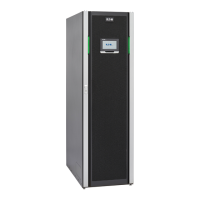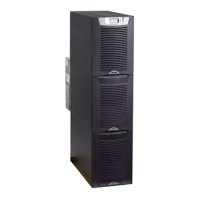45 Eaton® 9390 (100–160 kVA) UPS Installation and Operation Manual 164201604—Rev F
If the utility AC power is interrupted or is out of specification, the UPMs automatically switch to Battery mode
to support the critical load without interruption. When utility power returns, the UPMs return to Normal mode.
If the UPMs become overloaded or unavailable, the parallel system switches to Bypass mode. The parallel
system automatically returns to Normal mode when the overload condition is cleared and system operation is
restored within specified limits.
77..22..33 BByyppaassss MMooddee –– PPaarraalllleell
In Bypass mode, the output of the system is provided with three-phase AC power directly from the bypass
input. While in this mode, the output of the system is not protected from fluctuations, spikes, or power
outages from the source. No power filtering, conditioning, or battery support is available to the output of the
system in the Bypass mode of operation.
The parallel system automatically switches to Bypass mode if it detects a UPM overload, UPMs unavailable,
load fault, or internal failure.
Figure 15 shows the path of electrical power through the parallel system when operating in Bypass mode.
FFiigguurree 1155.. PPaatthh ooff CCuurrrreenntt tthhrroouugghh tthhee UUPPMMss iinn BByyppaassss MMooddee –– PPaarraalllleell
Main Power Flow
UPM 1
UPM 2
UPM 3
UPM 4
Output to
Critical
Load
Battery
UPM Input
Module Tie Cabinet
UPM 1 Output
Bypass Input
UPM 2 Output
UPM 3 Output
UPM 4 Output
Battery
Battery
Battery
Closed
Open
Breakers
In a parallel redundant or capacity type system, each module operates similar to a single module, but in parallel
with each other. The bypass source for the load is derived from the bypass input of one, two, three, or four
Understanding UPS Operation

